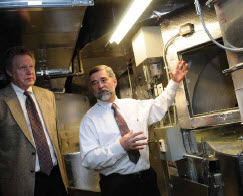“WHILE IT MAY SEEM A LONG WAY BETWEEN ARCHITECTURAL DRAWINGS TO CHANGING THE FILTER ON THE HVAC SYSTEM, MAKING SURE THAT ENERGY EFFICIENT, ‘GREEN’ BUILDINGS STAY GREEN STARTS AT THE DRAWING BOARD.”
Some facility owners and operators reject the concept of “green” and sustainable buildings, fearing higher initial costs and higher maintenance costs in the future. Others “go green” because they expect energy and maintenance cost savings over the life cycle of the building to easily offset the higher initial costs.
On average, however, facilities engineering professionals would agree that the “greens” have it right. “The small increase in upfront cost associated with energy efficiency systems is very small in comparison to savings over the life cycle of the building,” said Neil Maldeis, energy engineering manager for the Contracting Solutions Group at Trane Corporation, a company which employs more than 700 LEED® accredited engineers on its staff.
“For example, our analysis shows that a $10,000 extra initial investment upfront in energy efficient technologies could lead to $500,000 in savings over the life cycle of the system,” he said. Bill Gregory, director of sustainability at the Milliken Corporation, put it this way: “Some people think that going green will be more expensive when in many instances it saves money. Lower energy consumption, less maintenance and repairs or reduced disposal costs can make up for higher up-front costs.” So what does that mean for the facilities professionals whose job is to operate and maintain those systems? Will the greater complexity of these more sophisticated systems wreak havoc on your maintenance budget? Or will “going green” make it necessary for you to hire highly skilled outside experts with greater experience in these energy efficient and sustainable systems?
|
|
| Markim Hall at Macalester College, the first education facility in Minnesota to achieve LEED Platinum Certification. Photo courtesy of Trane, a business of Ingersoll Rand. |
|
|
| Mark Dickinson, director of facilities services, and Curt Stainbrook, mechanical systems manager, demonstrate features of the high-efficiency Trane HVACR system at Markim Hall. Photo courtesy of Trane, a business of Ingersoll Rand. |
Two organizations that have achieved LEED Certification for their facilities show that proper maintenanceif incorporated in the planning right from project inceptionis often the key to keeping the “green” in energy efficient, sustainable buildings.
Macalester College Partners with Trane for Smooth Operation
Mark Dickinson, director of facilities services at Macalester College in St. Paul, Minn., believes proper planning and the right choice of contractors are keys to ensuring that energy efficient systems can be maintained in a cost-effective manner using in-house staff. “If you get the systems correct it should be no more maintenance than a conventional building,” Dickinson said. Curt Stainbrook, an AFE Certified Plant Engineer and mechanical systems manager at Macalester College, noted that “the difference between a building like this one and a conventional system is the amount of sophistication that it takes to maintain it.
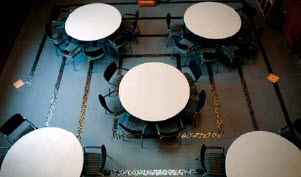 |
| Flooring made from recycled materials is used in Markim Hall. |
Sustainable systems can be more complicated and complex, so you really have to depend more than you normally might on the contractors you’re working with.” In the case of Markim Hall at Macalester Collegethe first college facility in Minnesota to achieve LEED Platinum statusone of those important contractor choices was with the Trane Corporation. Markim Hall uses 80 percent less energy compared with a typical college building in Minnesota, and does this without the use of solar or geothermal energy systems that was not an appropriate strategy for the college’s project. Instead, the key for them is an energy efficient hydronic heating and cooling system that uses radiant ceiling panels and additional in-floor heating in the entry and atrium, R-70 roof and R-40 wall insulation, double and triple glazed windows, the constant monitoring of heat, lights and humidity with sensors, and a Trane control system that allows users to easily operate their systems remotely using just an Internet connection. In addition, the building is connected to the campus’s central plant for chilled water and steam, and the updated central chiller plant has three Trane CenTraVac chillers that use no chlorofluorocarbon-based refrigerants. “The AdaptaView system learns how the chiller plant operates and suggests ways to improve the operation of the chiller plant, such as loading curves and leaving and entering temperatures, and strives to optimize them,” said Trane’s Maldeis. “Macalester can AdaptaView to monitor and report back to the operator’s booths on status of things such as flow meters, equipment on/off, and out of parameter. The system can create alerts and work orders when maintenance is due.” He added that the system will eventually allow Macalester to use predictive maintenance using information from controls throughout Markim Hall.
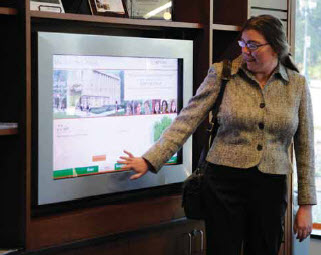 |
| Suzanne Savanick Hansen, sustainability manager, Macalester College, demonstrating the touch screen system that gives real time data about the efficiency of Markim Hall and the HVACR equipment for the campus. Photo courtesy of Trane, a business of Ingersoll Rand. |
Given the enormity and task of their heating and cooling system, any energy savings could have gone (literally) up in smoke without proper maintenance of their heating and cooling systems. For example, in order to provide chilled water for cooling 18 buildings on campus, the college’s chiller plant includes three, 860-ton Trane chillers and three Baltimore Air Coil (BAC) steel cooling towers.
The high efficiency of the chillers allow the Macalester team to reduce chiller load to 10 percent of demand, eliminating the need for smaller chillersand the need to maintain those smaller chillers. In order to increase energy efficiency for the entire campus, the Tracer system performs daily operations such as online scheduling, alarm management, troubleshooting, status updates, and data analysis.
So what does Maldeis believe is the key to Macalester’s success at maintaining their cost savings of 80 percent over other educational buildings in Minnesota? “A huge thing is the buy-in of everyone on the facilities and maintenance team at Macalester to the mission of the building,” he said. “While it may seem a long way between architectural drawings to changing the filter on the HVAC system, making sure that energy efficient, ‘green’ buildings stay green starts at the drawing board.”
 |
| Reporters tour Markim Hall and other sustainable facilities at Macalester College on Earth Day, 2010. Photo courtesy of Trane, a business of Ingersoll Rand. |
The Practical Side of a “Green” Retrofit
Unlike Macalester Collegewhose architects had LEED Certification in mind even before construction startedthe Virginia Beach Conference Center (VBCC) decided to retrofit their Skidmore Owings & Merrilldesigned building to qualify for LEED Gold Certification for Existing Buildings several years after its construction. “Although our building was not LEED Certified when it was built, it was designed to be very energy efficient,” said Lori J. Herrick, LEED AP, assistant manager of business at the Virginia Beach Conference Center.
“We did not want to spend money on things that would not have an immediate payback. Although we might not have solar panels on the roof, we make up for it by saving energy and achieving LEED points in a number of other ways,” said Herrick, adding that “there were some things we wanted to correct, such as the air handlers not closing properly. We had to spend some time and money getting them under control.” Brian Wall, P.E. and LEED AP, head of the mechanical engineering department at the Pace Collective PC, said the first step in achieving LEED Gold Certification for Existing Buildings was conducting planning and analysis “to determine what things were out of whack. Airflow measurements were taken and we saw areas where the [HVAC system] needed to be recalibrated and repaired. Ventilation air from the outside also needed to be manually adjusted and confirmed.” From those measurements, VBCC learned how to better maintain their heating and cooling system for peak efficiency and minimal environmental impact.
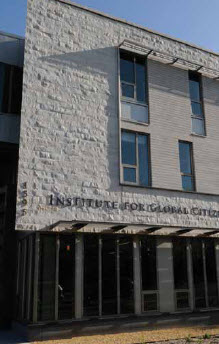 |
| Exterior of Markim Hall, a LEED Platinum Certified facility at Macalester College in St. Paul, Minn. Photo courtesy of Trane, a business of Ingersoll Rand. |
Is there a downside? Without proper maintenance, the energy efficient systems “will cease to work properly sooner than conventional systems will,” said Wall. “The downside to being on the cutting edge [of sustainable systems] is that those systems are more complex and can sometimes be more difficult to maintain and operate,” he added. “It takes some educating to get maintenance people to appreciate the more complex system.” By carefully monitoring and maintaining the existing high efficiency heating and air conditioning systemand with the help of existing tinted, energy efficient windows VBCC was able to drastically reduce energy and electricity use, helping the building to qualify for LEED certification.
In addition, VBCC found a number of other ways to achieve energy savings for its 500,000 square feet of exhibit space without using specialized systems like solar panels or geothermal. Sustainability initiatives at VBCC include several core programs such as recycling, water efficiency, energy efficiency and food and beverage that enable it to operate as efficiently as possible while reducing its impact on the environment. “Our mantra is ‘turn the lights off,'” Herrick said, adding that more than half of the incandescent bulbs have been replaced with more efficient CFLlighting.
 |
| The condenser pumps and tank for the cooling towers of the Macalester College chilled water plant. |
Other VBCC initiatives include lighting and HVAC systems that are programmed based on the events schedule to minimize usage during non-peak times. They also developed facilities work orders around things like erosion and sediment control, and changing job descriptions and performance reviews around ongoing LEED requirements. “Every member of the team is involved,” she said. “Even the concierge looks for peaks in energy use, and the housekeeping team has learned to put different types of items in different dumpsters for recycling.”
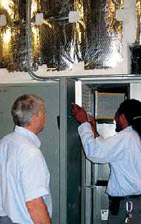 |
| Maintenance workers replace a filter in the high efficiency HVAC system at Virginia Beach Convention Center. Photo courtesy of the Virginia Beach Convention Center. |
Team cleaning is another example of how VBCC achieves energy efficiency in innovative ways. “Instead of each individual working on one room at a time, custodians work together to clean an area, meaning that lights only have to be turned on in areas that are being cleaned, ” said Herrick. As with VBCC, Macalester College’s Dickinson noted that the involvement of everyone is one of the keys to maintaining a sustainability program. “The success of the program is a function of our people not sitting on the sideline. They go out and get the information they need, and that takes interested people and committed people. It’s fine for the controls contractor to come here with information, but it’s no help if they don’t hear it,” he said.
Training from Trane
Properly maintaining sophisticated heating and cooling systems like the one at Macalester College’s Markim Hall can be challenging, but the college manages to do nearly all of their maintenance with their small in-house staff. One reason they are able to do so is the training they received from Trane, which was recently awarded a LEED award for their leadership in energy-efficient HVAC systems and their work educating customers on sustainable systems.
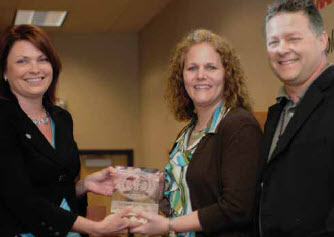 |
| Trane receives award from U.S. Green Building Council. Pictured (left to right) are: Sheri Brezinka, executive director of U.S. Green Building Council, Minnesota; Maria Jackson, Trane project manager, and Terry Dragich, Trane marketing services specialist. Photo courtesy of Trane, a business of Ingersoll Rand. |
“Trane walked us through the systems, and recorded the training for those who couldn’t be on-site,” Stainbrook said. “They made sure we had enough knowledge and experience with the system. Sometimes it was formal training, like the half-day they spent training us on chillers operation. Other times it, was training under fire when there was a problem or question about the system, since we’re on very lean staff very little time.”
That was just part of their job, according to Maldeis. “At Trane,” he noted, “we spend a lot of time educating the customer on the different maintenance procedures required to keep systems operating at optimal efficiency.”

